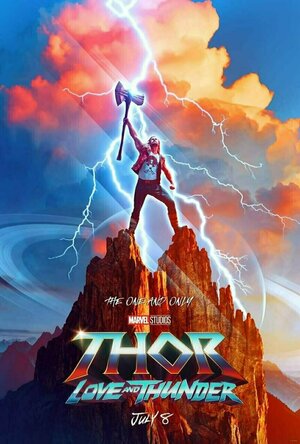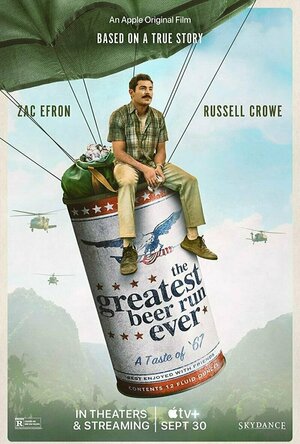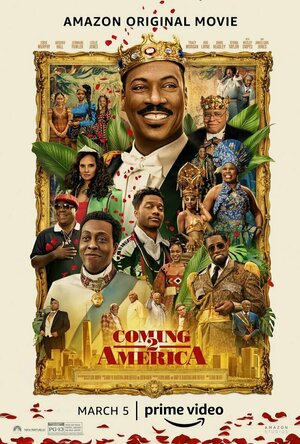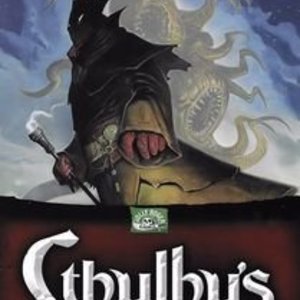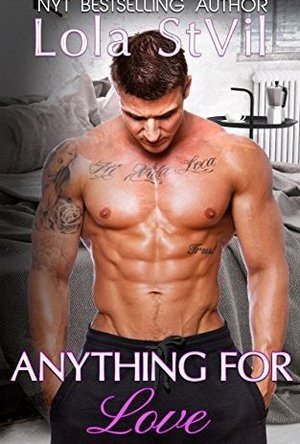Search
Search results

Moment – Screen Time Tracker
Health & Fitness and Productivity
App
Track how much you and your family use your phone and tablet each day, automatically • See what...

Seduction and Dating Quiz for Men and Women
Dating, Entertainment and Games
App
Welcome to the game “Seduction and Dating Quiz” – the App designed to turn you into a much...
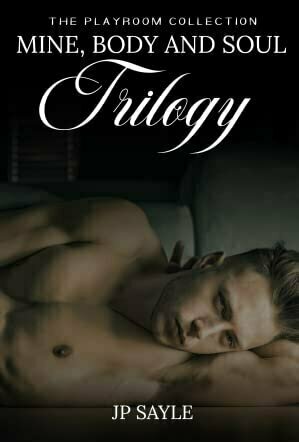
Mine, Body and Soul: Trilogy (The Playroom #1-3)
Book
Part One Was it possible that there was a man out there who could see past Lenny’s damaged body...
Contemporary MM Romance BDSM
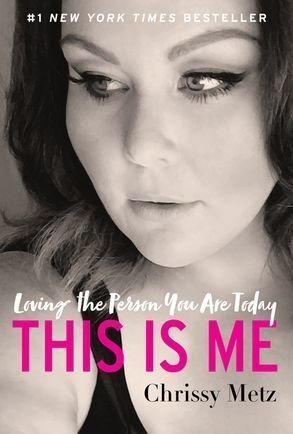
This Is Me: Loving the Person You Are Today
Book
An inspirational book about life and its lessons from the Golden Globe and Emmy nominated star of...
Celebrity Memoir Celebrity Humor Body Positivity Confidence
LeftSideCut (3776 KP) rated Thor: Love and Thunder (2022) in Movies
Aug 8, 2022
Phase four of the MCU has been interesting so far to say the least. Some projects have been great, some have been a little uninspired, but in its attempts to set up multiple overarching story threads, it feels a little wayward, especially in comparison to the recently concluded Infinity Saga. Thor: Love & Thunder has unfortunately arrived right in the middle of this new era of uncertainty, and is a film that ultimately feels a little directionless itself. It adapts a hugely beloved comic arc, an arc that could have potentially used two movies to flesh everything out properly. In this arc, Gorr the God Butcher is a big deal, he feels threatening, menacing, dangerous. In the film, Christian Bale is giving it his all, and there are moments when Gorr is genuinely creepy as hell, but the stakes never feel particularly high, resulting in a villain that feels like a shadow of his comic counterpart. Chris Hemsworth has proven by now that he is a perfect fit for Thor himself, but by this fourth entry, it genuinely feels that he is a straight up dumbass, and is miles away from his character growth in the first Thor. Herein lies the main issue I had with Love & Thunder. Ragnarok was a well balanced MCU film in terms of tone. It provided a much needed shakeup after the disappointment of The Dark World, and Taika Waititi was an inspired choice to bring the quirk. The comedy is tight, lands more often than not, whilst boasting some memorable set pieces. L&T takes the comedy aspect, and doubles down hard. It's joke after joke, to a point where a lot of it falls flat. It reminded me of Guardians of the Galaxy 2 in that respect. It's not terrible by any means, but it's balance feels completely off. There are some great set pieces to be fair. An early scene that involves an attack on New Asgard is a highlight, and almost feels like a horror film at times. It's also where we meet Jane Fosters Thor, who looks comic accurate, and is a genuinely great addition to the movie overall. There's another scene later on that takes place in the shadow realm that provides another highlight. It's mostly in black and white, and it feels unique to the MCU. It's one of a few inspired moments that prevent L&T from becoming a complete misfire.
Any other gripes from me would require stepping into spoiler territory so I'll leave it there. Love & Thunder is frequently dumb, but equally fun, colourful and loud, despite being a bit of a mess. The more Marvel Studios venture into Phase Four, the more sporadic and shaky it feels. I have no doubt that everything will plateau into a solid narrative again, I just hope that moment comes sooner, rather than later.
On a final note, the person I watched this with leaned over to me around the halfway point, and said that Thor just sounds like Boris Johnson when he talks, and now I can't unhear it. If I have to suffer, then you do to.
Any other gripes from me would require stepping into spoiler territory so I'll leave it there. Love & Thunder is frequently dumb, but equally fun, colourful and loud, despite being a bit of a mess. The more Marvel Studios venture into Phase Four, the more sporadic and shaky it feels. I have no doubt that everything will plateau into a solid narrative again, I just hope that moment comes sooner, rather than later.
On a final note, the person I watched this with leaned over to me around the halfway point, and said that Thor just sounds like Boris Johnson when he talks, and now I can't unhear it. If I have to suffer, then you do to.
BankofMarquis (1832 KP) rated The Greatest Beer Run Ever (2022) in Movies
Oct 10, 2022
Touched Me In The End
The new Apple TV+ original film THE GREATEST BEER RUN EVER is being advertised as kind of a “wacky buddy comedy” with a bunch of New York slackers looking for beer in Viet Nam.
This advertisement is doing this film a great disservice for this movie is much, much more than that and deserves some attention - and eyeballs looking at it.
Starring Zach Efron (who has turned into an actor who is much, much more than Troy Bolton of HIGH SCHOOL MUSICAL fame) and directed by Peter Farrelly (one of the Farrelly brothers that brought you such comedies as THERE’S SOMETHING ABOUT MARY and KINGPIN), THE GREATEST BEER RUN EVER tells the tale of a New Yorker in the late 1960’s who is big on talk and little on action. To shut those around him up, Chickie Donohue (Efron) decides to bring his buddies that are fighting in Viet Nam some beer from home. What starts out as a lark, evolves into something much more serious…and meaningful…for both Chickie and the audience.
Efron is quite good in the central role as Chickie and this film needs his inherent charisma in the center of this film as he is in every scene. Efron exudes goodness and sincerity even though, at times, he his speaking out of the sides of his mouth - or a place much further down his anatomy. And, as his character learns more and more about what is really going on in the war in Vietnam, his bravado and bluster fade and we get a glimpse of the real person underneath who is horrified by what he sees in this war.
Russell Crowe - who is finding a career renaissance in Supporting Roles - is strong (naturally) as a war photographer who befriends Chickie and takes him under his wing while the myriad of young, unknown actors who play Chickie’s friends scattered across various theaters of action in Viet Nam are appropriately played as folks who think what Chickie is doing is hilarious to those who are horrified that Chickie would voluntarily enter this war zone.
The tone of the film shifts from fun and silly to deep and meaningful throughout it’s 2 hour, 6 minute run-time, all under the watchful eye of Farrelly. He really has a handle on the deeper war-torn aspects of this film, while he (purposefully, I would imagine) shies away from his expected comedy and zaniness that could have been the first part of this movie. IMHO, Farrelly could have imparted some more zaniness at the start - to give the film a better kickstart (the beginning is a little slow) while also more starkly contrasting the beginning and end of the film - and the change in Chickie because of this experience.
I was drawn in - and touched - by the latter part of this BEER RUN and would strongly encourage everyone to check out this fine film.
Letter Grade: A-
8 stars (out of 10) and you can take that to the Bank(ofMarquis)
This advertisement is doing this film a great disservice for this movie is much, much more than that and deserves some attention - and eyeballs looking at it.
Starring Zach Efron (who has turned into an actor who is much, much more than Troy Bolton of HIGH SCHOOL MUSICAL fame) and directed by Peter Farrelly (one of the Farrelly brothers that brought you such comedies as THERE’S SOMETHING ABOUT MARY and KINGPIN), THE GREATEST BEER RUN EVER tells the tale of a New Yorker in the late 1960’s who is big on talk and little on action. To shut those around him up, Chickie Donohue (Efron) decides to bring his buddies that are fighting in Viet Nam some beer from home. What starts out as a lark, evolves into something much more serious…and meaningful…for both Chickie and the audience.
Efron is quite good in the central role as Chickie and this film needs his inherent charisma in the center of this film as he is in every scene. Efron exudes goodness and sincerity even though, at times, he his speaking out of the sides of his mouth - or a place much further down his anatomy. And, as his character learns more and more about what is really going on in the war in Vietnam, his bravado and bluster fade and we get a glimpse of the real person underneath who is horrified by what he sees in this war.
Russell Crowe - who is finding a career renaissance in Supporting Roles - is strong (naturally) as a war photographer who befriends Chickie and takes him under his wing while the myriad of young, unknown actors who play Chickie’s friends scattered across various theaters of action in Viet Nam are appropriately played as folks who think what Chickie is doing is hilarious to those who are horrified that Chickie would voluntarily enter this war zone.
The tone of the film shifts from fun and silly to deep and meaningful throughout it’s 2 hour, 6 minute run-time, all under the watchful eye of Farrelly. He really has a handle on the deeper war-torn aspects of this film, while he (purposefully, I would imagine) shies away from his expected comedy and zaniness that could have been the first part of this movie. IMHO, Farrelly could have imparted some more zaniness at the start - to give the film a better kickstart (the beginning is a little slow) while also more starkly contrasting the beginning and end of the film - and the change in Chickie because of this experience.
I was drawn in - and touched - by the latter part of this BEER RUN and would strongly encourage everyone to check out this fine film.
Letter Grade: A-
8 stars (out of 10) and you can take that to the Bank(ofMarquis)
Charlie Cobra Reviews (1840 KP) rated Coming 2 America (2021) in Movies
Mar 16, 2021 (Updated Mar 27, 2021)
Almost all of the original cast returns for this sequel (2 more)
Lots of laughs
Eddie Murphy and Arsenio Hall reprising many of the roles where they played multiple characters again.
Terrible character development (2 more)
Plot doesn't make sense at times or feels like missing scenes or plot development
Some jokes fall flat or feel forced and the trailer spoils some
Lots of Laughs and Callbacks But Not Enough Substance
Prince Akeem of Zamunda (Eddie Murphy) is visited by General Izzi (Wesley Snipes) who pushes for Akeem's eldest daughter Meeka (Kiki Layne) to marry his foppish son, Idi (Rotimi). Nexdoria is a hostile militaristic neighbor nation ruled by General Izzi, who is also the brother of Akeem's original arranged bride-to-be. Izzi threatens Akeem and says that it is better to be bound by blood and family then divided by blood and war. This occurs on the very day that Zamunda is celebrating the 30th anniversary of Prince Akeem and Lisa's wedding. King Jaffe Joffer (James Earl Jones) summons Akeem and Semmi (Arsenio Hall) and reminds them that only a male heir can inherit his kingdom. He summons his shaman Baba and they reveal that Akeem has a long lost son in America that he must retrieve in order to avoid a hostile takeover by Nexdoria.
I enjoyed this movie when I saw it the first time and thought that it was pretty funny. It definitely isn't a great movie but when compared to several other sequels that happen years after the original, I felt that it did better than most. It was for the most part a lesser version of the original but it's been years since I've seen the original and I didn't let my nostalgia for it to skew my opinion on this one. I do plan on re-watching the original soon though so I can see how much they differ. A big difference was that the original Coming to America is rated R and this sequel was PG-13. I usually hate when a company chooses to do this because I always feel what the fans/audience gets is a watered down version of the original but it's hard to say this time around. This movie was full of laughs and I was surprised how much they got away with it for being a PG-13 movie, however some of the jokes fell flat and a lot of them were given away in the trailer. Also there were somethings in the trailer that I didn't see in the movie; like the Wakanda joke in the barbershop. Wesley Snipes character General Izzi was quite a character and you could feel he was having fun portraying him. I also enjoyed Akeem's three daughters in the movie. I really liked the opening scene which showed Prince Akeem sparring with his daughters and stick fighting like the original movie. The middle daughter Princess Omma who had glasses was actually Eddie Murphy's daughter in real life, Bella Murphy. And I also heard that most of the palace scenes in Zamunda were actually filmed in rapper Rick Ross' house. As much as I liked this movie it also felt very thin and didn't have a lot of character development or much of a plot to speak of. It also felt like quite a few things didn't make sense and that characters that came out in the first movie were quite different personality wise or just by their actions. I feel like I should give this movie a lower score but I'm not sure if it's nostalgia again or the fact that since it's a comedy I'm not really letting some of those things bother me as much. I'll go over my many reasons for scoring it so low in the spoiler section but for now I give this movie a 6/10. I would say it's worth getting a free trial of Amazon Prime if you want to see it in good quality and for free, or if you already have Amazon Prime you should give it a shot if you're looking for some laughs, but if not you can totally wait to see this movie.
-------------------------------------------------------
Spoiler Section Review:
Alright so let's get to it. Like I said I enjoyed this movie and thought that it delivered on the laughs even if some of them were forced or fell flat. I also felt that it was pretty thin on the plot and from what I remember of the first movie some of the characters were off or acted very different personality wise. I loved how the movie began with Prince Akeem training with his daughters and doing the stick fighting which was one of many call backs to the original film. The conflict begins in the beginning of the movie when General Izzi visits Akeem and tries to arrange a marriage between his son and Akeem's oldest daughter, Princess Meeka. You can tell that Akeem doesn't like General Izzi's son Idi but doesn't say anything other than his daughter didn't find him suitable. General Izzi threatens him after making a comment about the King being dead or near death and Akeem not having any male heirs. I still don't understand the conflict between the two nations and felt that this would have benefitted the plot more if they would have explained it better. Why would he need an heir so soon if he himself hadn't even inherited the kingdom from his father yet? Also the only explanation between the conflict of the nations was that Nexdoria was poor and Zamunda was rich. Anyways then Akeem is summoned to see his father and his shaman Baba and is told that he has an illegitimate son in America after a tryst with a woman while being drugged. I thought this was pretty funny scene where they did a flashback to when it happened. So now Akeem and Semmi must travel to America to retrieve his son so that he can take the princely tests and become heir to the kingdom. This totally doesn't make any sense to me plot wise other than this is how they wanted the movie to go. Akeem was totally a person who went against his father's wishes and traditions in the first film to find his wife Lisa and doesn't make sense that he would get this "son" to be his heir even if he was blood without getting to know him first. However I ignored that while watching because I figured he would get to know him while they met and he went back to Zamunda with them. Also before the leave there is a pretty cool scene where King Jaffe Joffer decides to have his funeral while he's alive and it was very lavish and elegant and full of cameos from great artists and performers. It was funny to see the barbershop scene and how Eddie Murphy and Arsenio Hall reprised their roles of some of the barbershop characters when they arrive in America but I felt that the funny parts were already spoiled in the trailer. Also the part about Wakanda wasn't even in the movie. From there they find out that his son is selling tickets near Madison Square when they're told about the mascot being a thunderbird that was part of Baba's vision. That was a cool details that I wish would have been developed more to make it more interesting. It would have been cool for them to have struggled to find his son but instead the first place they go tells them exactly where he is. Also when he meets his son Lavelle, it didn't even come off as awkward enough and Lavelle totally takes him back to his house to meet everyone or ask his mom. I didn't see this as realistic or how it would have played out in real life. Leslie Jones was a pretty annoying character but I feel she fit the job of the role she played and that people are too harsh on her as an actor for this role but I do feel that she is like Kevin Hart or The Rock in basically being the same character in every role. She admits that Akeem could be Lavelle's father and just like that they are whisked away to Zamunda. No paternity test, no lie detector test, no witnesses like her friend in the club saying yes it was true. This was very unrealistic to me because anybody would say yes to inherit the riches of Zamunda. When he returns Princess Lisa confronts him about him having a son and the particulars of how it occurred and she was shocked to find out that he brought not only his son but the son's mother back with him as well. General Izzi returns to Zamunda as soon as Prince Lavelle returns and makes it known that he has a daughter that he wishes for him to marry and Prince Akeem un-characteristically allows this arranged marriage to take place. Prince Lavelle must now pass the 3 princely tests first, which consist of knowledge of his ancestors/predecessors, getting the whiskers of a lion, and also one which involved ritual circumcision. I felt like there wasn't enough character development during these scenes and also the ones where Lavelle interacted with Mirembe, his royal barber to warrant the closeness that they all experienced. Princess Meeka, Akeem's oldest daughter is very upset about being passes up as heir for being a woman and rightly dislikes Lavelle and it totally seems out of character for her to aid him in passing his test to get the lion whiskers. They only had a small exchange about being written off or being judged for how they look or talk. And I felt that Lavelle also didn't have enough rapport with his barber Mirembe to be falling in love with her in under a week, or if they did it wasn't shown enough to us. There was a lot that didn't make sense or I feel was cut from the movie or even worse, just bad writing and poor plot development and it wasn't done right. The worse had to have been seeing Akeem's character become the opposite of who he was in the first movie. He passes over his daughter to give the throne to a stranger because he is a man and even when he loses his patience with a drunk or inebriated Lisa and tells her to shut her mouth after the celebration of the upcoming wedding between Lavelle and Bopoto, General Izzi's daughter. All in all I have to say that for me personally this movie was full of laughs but just had so much wrong with it that I should really be rating it a 5 or just an average movie. However there are so many sequels that happen 5 years or more after the original that are far worse or just as bad that I feel since this one was 30 years later it wasn't as bad as others are judging it. But maybe if I had seen the original right before seeing this one I would have changed by rating but for now I'm not sure if it's nostalgia or just bias but I rate this movie a 6/10. If you thought the original was funny then you more than likely will like this movie but if the original is a special movie to you that holds a special place in your heart then you might just think this sequel is utter trash.
https://youtu.be/-tT8Wy3YeI4
I enjoyed this movie when I saw it the first time and thought that it was pretty funny. It definitely isn't a great movie but when compared to several other sequels that happen years after the original, I felt that it did better than most. It was for the most part a lesser version of the original but it's been years since I've seen the original and I didn't let my nostalgia for it to skew my opinion on this one. I do plan on re-watching the original soon though so I can see how much they differ. A big difference was that the original Coming to America is rated R and this sequel was PG-13. I usually hate when a company chooses to do this because I always feel what the fans/audience gets is a watered down version of the original but it's hard to say this time around. This movie was full of laughs and I was surprised how much they got away with it for being a PG-13 movie, however some of the jokes fell flat and a lot of them were given away in the trailer. Also there were somethings in the trailer that I didn't see in the movie; like the Wakanda joke in the barbershop. Wesley Snipes character General Izzi was quite a character and you could feel he was having fun portraying him. I also enjoyed Akeem's three daughters in the movie. I really liked the opening scene which showed Prince Akeem sparring with his daughters and stick fighting like the original movie. The middle daughter Princess Omma who had glasses was actually Eddie Murphy's daughter in real life, Bella Murphy. And I also heard that most of the palace scenes in Zamunda were actually filmed in rapper Rick Ross' house. As much as I liked this movie it also felt very thin and didn't have a lot of character development or much of a plot to speak of. It also felt like quite a few things didn't make sense and that characters that came out in the first movie were quite different personality wise or just by their actions. I feel like I should give this movie a lower score but I'm not sure if it's nostalgia again or the fact that since it's a comedy I'm not really letting some of those things bother me as much. I'll go over my many reasons for scoring it so low in the spoiler section but for now I give this movie a 6/10. I would say it's worth getting a free trial of Amazon Prime if you want to see it in good quality and for free, or if you already have Amazon Prime you should give it a shot if you're looking for some laughs, but if not you can totally wait to see this movie.
-------------------------------------------------------
Spoiler Section Review:
Alright so let's get to it. Like I said I enjoyed this movie and thought that it delivered on the laughs even if some of them were forced or fell flat. I also felt that it was pretty thin on the plot and from what I remember of the first movie some of the characters were off or acted very different personality wise. I loved how the movie began with Prince Akeem training with his daughters and doing the stick fighting which was one of many call backs to the original film. The conflict begins in the beginning of the movie when General Izzi visits Akeem and tries to arrange a marriage between his son and Akeem's oldest daughter, Princess Meeka. You can tell that Akeem doesn't like General Izzi's son Idi but doesn't say anything other than his daughter didn't find him suitable. General Izzi threatens him after making a comment about the King being dead or near death and Akeem not having any male heirs. I still don't understand the conflict between the two nations and felt that this would have benefitted the plot more if they would have explained it better. Why would he need an heir so soon if he himself hadn't even inherited the kingdom from his father yet? Also the only explanation between the conflict of the nations was that Nexdoria was poor and Zamunda was rich. Anyways then Akeem is summoned to see his father and his shaman Baba and is told that he has an illegitimate son in America after a tryst with a woman while being drugged. I thought this was pretty funny scene where they did a flashback to when it happened. So now Akeem and Semmi must travel to America to retrieve his son so that he can take the princely tests and become heir to the kingdom. This totally doesn't make any sense to me plot wise other than this is how they wanted the movie to go. Akeem was totally a person who went against his father's wishes and traditions in the first film to find his wife Lisa and doesn't make sense that he would get this "son" to be his heir even if he was blood without getting to know him first. However I ignored that while watching because I figured he would get to know him while they met and he went back to Zamunda with them. Also before the leave there is a pretty cool scene where King Jaffe Joffer decides to have his funeral while he's alive and it was very lavish and elegant and full of cameos from great artists and performers. It was funny to see the barbershop scene and how Eddie Murphy and Arsenio Hall reprised their roles of some of the barbershop characters when they arrive in America but I felt that the funny parts were already spoiled in the trailer. Also the part about Wakanda wasn't even in the movie. From there they find out that his son is selling tickets near Madison Square when they're told about the mascot being a thunderbird that was part of Baba's vision. That was a cool details that I wish would have been developed more to make it more interesting. It would have been cool for them to have struggled to find his son but instead the first place they go tells them exactly where he is. Also when he meets his son Lavelle, it didn't even come off as awkward enough and Lavelle totally takes him back to his house to meet everyone or ask his mom. I didn't see this as realistic or how it would have played out in real life. Leslie Jones was a pretty annoying character but I feel she fit the job of the role she played and that people are too harsh on her as an actor for this role but I do feel that she is like Kevin Hart or The Rock in basically being the same character in every role. She admits that Akeem could be Lavelle's father and just like that they are whisked away to Zamunda. No paternity test, no lie detector test, no witnesses like her friend in the club saying yes it was true. This was very unrealistic to me because anybody would say yes to inherit the riches of Zamunda. When he returns Princess Lisa confronts him about him having a son and the particulars of how it occurred and she was shocked to find out that he brought not only his son but the son's mother back with him as well. General Izzi returns to Zamunda as soon as Prince Lavelle returns and makes it known that he has a daughter that he wishes for him to marry and Prince Akeem un-characteristically allows this arranged marriage to take place. Prince Lavelle must now pass the 3 princely tests first, which consist of knowledge of his ancestors/predecessors, getting the whiskers of a lion, and also one which involved ritual circumcision. I felt like there wasn't enough character development during these scenes and also the ones where Lavelle interacted with Mirembe, his royal barber to warrant the closeness that they all experienced. Princess Meeka, Akeem's oldest daughter is very upset about being passes up as heir for being a woman and rightly dislikes Lavelle and it totally seems out of character for her to aid him in passing his test to get the lion whiskers. They only had a small exchange about being written off or being judged for how they look or talk. And I felt that Lavelle also didn't have enough rapport with his barber Mirembe to be falling in love with her in under a week, or if they did it wasn't shown enough to us. There was a lot that didn't make sense or I feel was cut from the movie or even worse, just bad writing and poor plot development and it wasn't done right. The worse had to have been seeing Akeem's character become the opposite of who he was in the first movie. He passes over his daughter to give the throne to a stranger because he is a man and even when he loses his patience with a drunk or inebriated Lisa and tells her to shut her mouth after the celebration of the upcoming wedding between Lavelle and Bopoto, General Izzi's daughter. All in all I have to say that for me personally this movie was full of laughs but just had so much wrong with it that I should really be rating it a 5 or just an average movie. However there are so many sequels that happen 5 years or more after the original that are far worse or just as bad that I feel since this one was 30 years later it wasn't as bad as others are judging it. But maybe if I had seen the original right before seeing this one I would have changed by rating but for now I'm not sure if it's nostalgia or just bias but I rate this movie a 6/10. If you thought the original was funny then you more than likely will like this movie but if the original is a special movie to you that holds a special place in your heart then you might just think this sequel is utter trash.
https://youtu.be/-tT8Wy3YeI4
Purple Phoenix Games (2266 KP) rated Cthulhu's Vault in Tabletop Games
Nov 9, 2021
As a kid, one thing my siblings and I used to do was play a storytelling game in which we created a (usually) hilarious story, one word at a time. You know the kind. One person starts the sentence with a single word, the next person in line adds a word, and so on, resulting in some ridiculous storyline that ultimately makes little overall sense. So when I heard about Cthulhu’s Vault, a game with a storytelling aspect, I was keen to try it! Even though the subject matter is obviously a little darker, does the overall game live up to my childhood memories of creating stories?
Cthulhu’s Vault is a card game in which players are working together to craft an occult story, which will ultimately lead to a final battle with one of the Ancient Ones. To setup the game, each player receives an Ancient One card (kept face-down), 7 Story cards, and 2 Power tokens (one Investigator and one Cultist). Power tokens are kept face-down and are secret from other players. The remaining Power tokens are placed into two pools – either face-up or face-down as described in the rules – and a starting Story card is drawn and placed in the middle of the play area. The Power Guide card is placed off to the side, visible to players, and shows the amount of Cultist Power necessary to awaken your Ancient One during play. Select a starting player, and the game is ready to begin!
The game is broken down into two phases: the Mystery Stage and the Epic Battle Stage. The Mystery Stage begins the game, and consists of the storytelling element. On your turn, you will select a Story card from your hand and play it to the table. Here’s the catch – all players are trying to create a cohesive storyline, so you are encouraged to narrate and chain together a single story with the addition of each new Story card. After you play your Story card and tell your brief addition to the tale, you will collect a number of Power tokens as described on your played Story card, receiving Bonus tokens if applicable. The Mystery Stage continues in this fashion until a player has acquired the requisite number of Cultist Power tokens necessary to awaken their Ancient One. At the start of that turn, the player will reveal their Ancient One, and the Mystery Stage ends immediately.
Moving on to the Epic Battle Stage, there is a small bit of setup. All remaining Story cards are discarded, and Investigator cards are displayed. The player who awoke their Ancient One collects a number of Power tokens equal to the health of their creature, gathers/shuffles the Ancient One Combat Deck, and draws a hand of 3 Combat cards. All remaining players will select an Investigator to play, in order, depending on the total number of Investigator Power tokens gained during the Mystery Stage. Players will discard down to/collect a number of Power tokens to match the health of their Investigator, shuffle the Investigator Combat Deck, and draw a number of cards as dictated by their Investigator card. A Battle Order deck is created and shuffled, and will dictate the order of actions during each Epic Battle turn. The Epic Battle Stage is now ready to begin.
During the Epic Battle, a card from the Battle Order deck is revealed – either an Investigator or the Ancient One. The corresponding player will then act, playing a card from their hand, performing the action (usually Wounding the opponent), and then drawing back up to their hand limit. Play continues in this way until either the Ancient One is defeated (all Health depleted), or all the Investigators are devoured by the Ancient One. If the Ancient One is defeated, the Investigators have won! And if the Ancient One has eliminated all the Investigators, then that player wins. Either way, whomever wins is encouraged to come up with a brief epilogue to bring the overall story to an end.
So all in all, how does Cthulhu’s Vault fare? Honestly, not too great. Let’s start with the rulebook. It has some areas of serious ambiguity and confusion, which made this game kind of tough and frustrating for me to learn at first. Now that I think I’ve got it figured out, it’s ok, but that first read-through was rough. Now getting down to the actual gameplay. I can appreciate what the game is trying to do – have players create a story and then engage in their narrated battle – but the two phases of the game seem very disjointed to me. It kind of feels like you are playing 2 separate games in one. You get to have some creative fun making up a spooky story, which is then swiftly forgotten as combat ensues. There is little to no connection between the two phases, and that lack of connection makes the storytelling phase seem obsolete.
Another thing to consider when checking this game out is the group of people with whom you will play. To really get a fun, immersive story going, all players need to be willing to embrace the storytelling aspect, and get into the narrative. Requiring that type of creativity on the spot can make some players uncomfortable, and they just might not enjoy that element of the game. Let’s touch on components for a minute. I think that for the most part, the production quality is fine! The Story, Investigator, and Ancient One cards are all oversized, sturdy, and feature some neat spooky art and flavor text. The Combat cards are normal sized, and for the most part clear in their text/actions. The Power tokens are small wooden discs, and are fun to play with. The version I have is in a tin, not a cardboard box, and the tin is nice and sturdy too. Overall, good quality game.
In theory, I think Cthulhu’s Vault is a neat game. The actual execution of the gameplay doesn’t quite hit the mark for me though. The lack of connection between the two phases of the game really detracts from the overall immersion. If there were a stronger connection, perhaps I would like it more, but as it stands, it just feels like 2 separate games in one box. If you’re into storytelling games, I would consider Cthulhu’s Vault because it does provide a neat opportunity for players to craft a unified story. But the shift to the combat phase feels sudden and unrelated. Purple Phoenix Games gives this one a fiendish 5 / 12.
Cthulhu’s Vault is a card game in which players are working together to craft an occult story, which will ultimately lead to a final battle with one of the Ancient Ones. To setup the game, each player receives an Ancient One card (kept face-down), 7 Story cards, and 2 Power tokens (one Investigator and one Cultist). Power tokens are kept face-down and are secret from other players. The remaining Power tokens are placed into two pools – either face-up or face-down as described in the rules – and a starting Story card is drawn and placed in the middle of the play area. The Power Guide card is placed off to the side, visible to players, and shows the amount of Cultist Power necessary to awaken your Ancient One during play. Select a starting player, and the game is ready to begin!
The game is broken down into two phases: the Mystery Stage and the Epic Battle Stage. The Mystery Stage begins the game, and consists of the storytelling element. On your turn, you will select a Story card from your hand and play it to the table. Here’s the catch – all players are trying to create a cohesive storyline, so you are encouraged to narrate and chain together a single story with the addition of each new Story card. After you play your Story card and tell your brief addition to the tale, you will collect a number of Power tokens as described on your played Story card, receiving Bonus tokens if applicable. The Mystery Stage continues in this fashion until a player has acquired the requisite number of Cultist Power tokens necessary to awaken their Ancient One. At the start of that turn, the player will reveal their Ancient One, and the Mystery Stage ends immediately.
Moving on to the Epic Battle Stage, there is a small bit of setup. All remaining Story cards are discarded, and Investigator cards are displayed. The player who awoke their Ancient One collects a number of Power tokens equal to the health of their creature, gathers/shuffles the Ancient One Combat Deck, and draws a hand of 3 Combat cards. All remaining players will select an Investigator to play, in order, depending on the total number of Investigator Power tokens gained during the Mystery Stage. Players will discard down to/collect a number of Power tokens to match the health of their Investigator, shuffle the Investigator Combat Deck, and draw a number of cards as dictated by their Investigator card. A Battle Order deck is created and shuffled, and will dictate the order of actions during each Epic Battle turn. The Epic Battle Stage is now ready to begin.
During the Epic Battle, a card from the Battle Order deck is revealed – either an Investigator or the Ancient One. The corresponding player will then act, playing a card from their hand, performing the action (usually Wounding the opponent), and then drawing back up to their hand limit. Play continues in this way until either the Ancient One is defeated (all Health depleted), or all the Investigators are devoured by the Ancient One. If the Ancient One is defeated, the Investigators have won! And if the Ancient One has eliminated all the Investigators, then that player wins. Either way, whomever wins is encouraged to come up with a brief epilogue to bring the overall story to an end.
So all in all, how does Cthulhu’s Vault fare? Honestly, not too great. Let’s start with the rulebook. It has some areas of serious ambiguity and confusion, which made this game kind of tough and frustrating for me to learn at first. Now that I think I’ve got it figured out, it’s ok, but that first read-through was rough. Now getting down to the actual gameplay. I can appreciate what the game is trying to do – have players create a story and then engage in their narrated battle – but the two phases of the game seem very disjointed to me. It kind of feels like you are playing 2 separate games in one. You get to have some creative fun making up a spooky story, which is then swiftly forgotten as combat ensues. There is little to no connection between the two phases, and that lack of connection makes the storytelling phase seem obsolete.
Another thing to consider when checking this game out is the group of people with whom you will play. To really get a fun, immersive story going, all players need to be willing to embrace the storytelling aspect, and get into the narrative. Requiring that type of creativity on the spot can make some players uncomfortable, and they just might not enjoy that element of the game. Let’s touch on components for a minute. I think that for the most part, the production quality is fine! The Story, Investigator, and Ancient One cards are all oversized, sturdy, and feature some neat spooky art and flavor text. The Combat cards are normal sized, and for the most part clear in their text/actions. The Power tokens are small wooden discs, and are fun to play with. The version I have is in a tin, not a cardboard box, and the tin is nice and sturdy too. Overall, good quality game.
In theory, I think Cthulhu’s Vault is a neat game. The actual execution of the gameplay doesn’t quite hit the mark for me though. The lack of connection between the two phases of the game really detracts from the overall immersion. If there were a stronger connection, perhaps I would like it more, but as it stands, it just feels like 2 separate games in one box. If you’re into storytelling games, I would consider Cthulhu’s Vault because it does provide a neat opportunity for players to craft a unified story. But the shift to the combat phase feels sudden and unrelated. Purple Phoenix Games gives this one a fiendish 5 / 12.
KittyMiku (138 KP) rated Anything For Love in Books
Apr 10, 2019
Relatable characters (1 more)
Full of mystery and action
Contains spoilers, click to show
I would first like to say I don't normally like these short little romance novels, but I really enjoyed this one. I often find the short romance novels like this are rushed or leaves something to be desired at the end. In Anything for Love, I found that the story was relatable and quite enjoyable to read. It left you smiling at the end and it felt complete. I don't have many complaints, just a few grammatical errors that are easily overlooked, as there might have been at most five in total. It was the characters that made the story for me, especially Winter.
Winter's past was rough, especially where her ex, Danny, was concerned. With the betrayal and manipulative nature he had, I wouldn't have blamed Winter for closing herself off to the world of dating. Even though you don't get the full extent of what he did to her, besides being a jerk, until she tells Wyatt why she is so closed off to him, you can't help but understand what she is going through. Most women swear off dating when they break up with a particular nasty relationship. Though, it rarely sticks, its not hard to see Winter is a vary realistic character, that many women can relate to. It was very nice to see that she had made up her mind and did everything in her power to stay away from Wyatt, knowing she wasn't ready for a relationship or to trust another man. It wasn't just her heart and how I could relate to her in the romance department that got me, it was her strength and determination to protect the children she helped. Her concern and kindness for the kids who are in group homes waiting to be adopted, melted my heart. It was very clear that those kids meant the world to her, even more than her own life. Not many people would stand up to a gang and even deny them a new recruit, putting their life at risk, to protect a child that wasn't theirs and yet she did. She not only kept the kid, Carlos, safe from the gang life, but she made sure she got him into an art class, so that he would be able to further his education on that which he loves. It made it easy to see how someone could fall in love with her.
While Winter is a little closed off to dating and more focused on the kids that attend her center, Wyatt is more determined to win her over while being the cop he is. At first you want to hate him. He comes off arrogant and career oriented, as well as a horn dog. It is clear he wants to be with her sexually and his determination makes you slightly wonder if he would do anything unsavory to achieve this. However, that opinion dissolves quickly after Winter allows him to take her out to hang out a bit during a Halloween party her co-worker and bestfriend throws. Wyatt shows genuine interest in Winter and even appears to be a really good guy, but what amazed me was that fact he never did anything to push her into kissing him, having sex or anything. He was patient, kind and understanding, even before Winter finally told him what Danny had done to her in her past. Though he seemed demanding and a bit of someone who would be controlling, it was nice to see the softer side of him too. To be able to find someone who won't take no as an answer, but also be patient and considerate of another's feelings is a rare trait to have. Normally, you don't see both those traits in a single person, but Wyatt has them and it makes for interesting guy. Your heart automatically goes out to him as you watch him be patient with Winter. At points, I found myself yelling at Winter because of how broken she was. I understand where she was coming from, having been in horrid relationships myself, but I would like to think if I was her, I would have been a bit more willing to trust him sooner than she did. Wyatt is a definite dream hunk and will be your book boyfriend if you only let him love you.
I have say that this book kept me thirsty for more, especially since so much was left out to keep it a bit suspenseful. I loved how the gang, Street Kings, was left alone after Winter confronts them to leave Carlos alone, that you nearly forget about them being in the picture. It made for a nice little dramatic event when they pop back up. Or when you learn more about Wyatt that is kept being hinted at throughout the story. I found this all to make quite a compelling story. It had the right amount of suspense, mystery and action to make this romance novel that perfect read in my opinion. I would recommend it to all my romance readers. I would rate this book 4 stars out of 5 stars simply because of the few grammar errors I had found while reading, Though they didn't take away from enjoying the book, I still wish they hadn't been present. It can ruin any grammar freak's day.
Anything for Love is free for the Kindle, and that's without Kinde Unlimited. It is also the first book in the series "The Hunter Brothers." I do hope you go to check it out and grab your copy from Amazon while it is free to grab. Happy Reading!
Winter's past was rough, especially where her ex, Danny, was concerned. With the betrayal and manipulative nature he had, I wouldn't have blamed Winter for closing herself off to the world of dating. Even though you don't get the full extent of what he did to her, besides being a jerk, until she tells Wyatt why she is so closed off to him, you can't help but understand what she is going through. Most women swear off dating when they break up with a particular nasty relationship. Though, it rarely sticks, its not hard to see Winter is a vary realistic character, that many women can relate to. It was very nice to see that she had made up her mind and did everything in her power to stay away from Wyatt, knowing she wasn't ready for a relationship or to trust another man. It wasn't just her heart and how I could relate to her in the romance department that got me, it was her strength and determination to protect the children she helped. Her concern and kindness for the kids who are in group homes waiting to be adopted, melted my heart. It was very clear that those kids meant the world to her, even more than her own life. Not many people would stand up to a gang and even deny them a new recruit, putting their life at risk, to protect a child that wasn't theirs and yet she did. She not only kept the kid, Carlos, safe from the gang life, but she made sure she got him into an art class, so that he would be able to further his education on that which he loves. It made it easy to see how someone could fall in love with her.
While Winter is a little closed off to dating and more focused on the kids that attend her center, Wyatt is more determined to win her over while being the cop he is. At first you want to hate him. He comes off arrogant and career oriented, as well as a horn dog. It is clear he wants to be with her sexually and his determination makes you slightly wonder if he would do anything unsavory to achieve this. However, that opinion dissolves quickly after Winter allows him to take her out to hang out a bit during a Halloween party her co-worker and bestfriend throws. Wyatt shows genuine interest in Winter and even appears to be a really good guy, but what amazed me was that fact he never did anything to push her into kissing him, having sex or anything. He was patient, kind and understanding, even before Winter finally told him what Danny had done to her in her past. Though he seemed demanding and a bit of someone who would be controlling, it was nice to see the softer side of him too. To be able to find someone who won't take no as an answer, but also be patient and considerate of another's feelings is a rare trait to have. Normally, you don't see both those traits in a single person, but Wyatt has them and it makes for interesting guy. Your heart automatically goes out to him as you watch him be patient with Winter. At points, I found myself yelling at Winter because of how broken she was. I understand where she was coming from, having been in horrid relationships myself, but I would like to think if I was her, I would have been a bit more willing to trust him sooner than she did. Wyatt is a definite dream hunk and will be your book boyfriend if you only let him love you.
I have say that this book kept me thirsty for more, especially since so much was left out to keep it a bit suspenseful. I loved how the gang, Street Kings, was left alone after Winter confronts them to leave Carlos alone, that you nearly forget about them being in the picture. It made for a nice little dramatic event when they pop back up. Or when you learn more about Wyatt that is kept being hinted at throughout the story. I found this all to make quite a compelling story. It had the right amount of suspense, mystery and action to make this romance novel that perfect read in my opinion. I would recommend it to all my romance readers. I would rate this book 4 stars out of 5 stars simply because of the few grammar errors I had found while reading, Though they didn't take away from enjoying the book, I still wish they hadn't been present. It can ruin any grammar freak's day.
Anything for Love is free for the Kindle, and that's without Kinde Unlimited. It is also the first book in the series "The Hunter Brothers." I do hope you go to check it out and grab your copy from Amazon while it is free to grab. Happy Reading!

